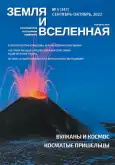Shaggy Visitors
- Authors: Basilevsky A.T1
-
Affiliations:
- Vernadsky Institute of Geochemistry and Analytical Chemistry, Russian Academy of Sciences
- Issue: No 5 (2022)
- Pages: 19-29
- Section: Articles
- URL: https://journals.eco-vector.com/0044-3948/article/view/628505
- DOI: https://doi.org/10.7868/S0044394822050024
- ID: 628505
Cite item
Abstract
Comets are small celestial bodies, which orbit the Sun along highly elliptical trajectories. They are divided into short- (< 200 years) and long-period (>200 years) comets. They have solid nuclei with diameters varying from hundreds of meters to several tens of kilometers, which contain water ice and other volatiles. When comets approach the Sun, these volatile compounds evaporate and stream ‘upwards’, carrying along solid particles. As a result, a coma of dust and gas, surrounding the nucleus, appears, and then the pressure of solar radiation turns it into a comet’s ‘tail’, also made from gas and dust. Comet’s nucleus matter is solid, but highly porous and fragile. Its surface is covered with fissures, depressions of irregular form, and various elevations. However unusual, from the point of view of terrestrial geologist, the conditions on the comet’s surface are, the geological processes, which ‘work’ there, are quite common. On the surface, solid matter becomes loose cover, which slides down the steep slopes. The resulting relief is defined by its resistance to destruction. These topics are the subject of the paper.
About the authors
A. T Basilevsky
Vernadsky Institute of Geochemistry and Analytical Chemistry, Russian Academy of Sciences
References
- Базилевский А.Т., Келлер Х.У. Кратеры, участки гладкой поверхности, потоки и слоистость на ядрах комет // Астрономический вестник. 2007. Т. 41. № 2. C. 1–10.
- Базилевский А.Т., Красильников С.С., Ширяев А.А., Маль У., Келлер Х.У., Скоров Ю.В., Моттола С., Хвид Ш.Ф. Оценка прочности материала ядра кометы 67P/Чурюмова–Герасименко // Астрономический вестник. 2016. Т. 50, № 4. C. 241–251.
- Фесенков В.Г. О природе Тунгусского метеорита // Метеоритика. 1961. Вып. XX. C. 27–31.
- Флоренский К.П. Проблема космической пыли и современное состояние изучения Тунгусского метеорита // Геохимия. 1963. № 3. C. 284–296.
- Fulle M., Corte D.V., Rotundi A., Green S.F., Accolla M., Colangeli L., Ferrari M., Ivanovski S., Sordini R., Zakharov V. The dust-to-ices ratio in comets and Kuiper belt objects // Monthly Notices of the Royal Astronomical Society. 2017. V. 469. P. S45–S49.
- Krasilnikov S.S., Skorov Y.V., Basilevsky A.T., Hviid S.F., Mall U. and Keller H.U. Pinnacles on the surface of the comet 67P/Churyumov–Gerasimenko: Regional distribution and morphology // Monthly Notices of the Royal Astronomical Society. 2020. V. 491. P. 2664–2673.
- Sierks H., Barbieri C., Lamy P.L. et al. On the nucleus structure and activity of comet 67P/ Churyumov–Gerasimenko // Science. 2015. V. 347 (6220).
- Thomas N., Ulamec S., Kührt E., Ciarletti V., Gundlach B., Yoldi Z. Schwehm G., Snodgrass C., Green S.F. Towards new comet missions // Space Science Reviews. 2019. V. 215 (8). P. 1–35.
Supplementary files






